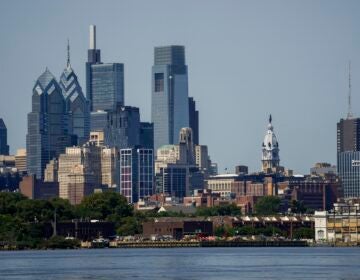The American Revolution museum aims to feel more like a movie than a book [photos]
ListenThe Museum of the American Revolution is filled with every trick in the curatorial bag —from digital touch screens that let you explore the historical context of complicated documents, to filmed re-enactments, to immersive environments, to old-school dioramas of life-sized American militia soldiers getting into fights with each other, their cheeks red from cold and fisticuffs.
“We should think of this as a movie you can walk through,” said the museum’s vice president of exhibitions, Scott Stephenson, “not a book we are illustrating.”
Author David McCullough, who has won two Pulitzer Prizes for his history books, is OK with that.
“The opportunities for creative innovation in museums is wide-open,” he said. “They don’t all need to be flat things on a flat wall. That can be part of it, but it can be more than that.”
The institution takes care not to position itself as a museum of the Revolutionary War. While it does feature an impressive collection of period weaponry — including an entire room of antique rifles — this is not a war museum. Rather, it is a monument to the ideals, struggles, infighting, mistakes, contradictions, failures, and heroes of the movement for independence that created a nation.
The museum also attempts to dismantle the notion that history is written by the victors. The spoils of the American Revolution were not enjoyed by women, African-Americans, Native Americans, and British Loyalists, all of whom make appearances in the exhibition.
“The people who founded this country were not just a bunch of white men in tights and wigs,” said Cokie Roberts, NPR political commentator and author of “Founding Mothers: The Women Who Raised Our Nation.” “Abigail Adams wrote that patriotism in a woman’s breast is the most unselfish of virtues, because women were not going to get anything out of this.”
One of the museum exhibitions is a re-creation of a Colonial pantry, where the woman of the house had boycotted all British household goods, as a means to fight the Revolution on the economic front.
In his remarks at the ribbon-cutting, Harvard University African-American studies professor Vincent Brown brought up Harry Washington, one of George Washington’s slaves at Mount Vernon who escaped to joined the British Army. After the war, he would eventually migrate to Sierra Leone.
While he did not benefit from the Revolution — he actually fought against it — Brown said Harry Washington had absorbed America’s Revolutionary ideals.
“In 1800, he joined another rebellion against the British in that African colony,” said Brown. “Although Harry’s revolt failed, we can know he embodied an American spirit of revolution as certainly as George.”
In many ways, the American Revolution was a mess. While the military conflict can be more or less bookended by identifiable events — the infamous “Shot Heard Round the World” in the Battles of Lexington and Concord, up to the Siege of Yorktown — the ideological origins of the Revolution are murky; some say its end has yet to happen.
The curators admit the Revolution is a tough nut to crack, because the story is about more than battlegrounds and troop movements. It’s about a class of wealthy landowning men who rebelled for an ideal, and rallied the young nation around that ideal.
The museum features a life-size diorama of militia soldiers from New England and Pennsylvania locked in a fistfight, with Gen. George Washington in the middle, trying to keep his troops from beating each other up.
This happened in 1775, when the British staged an aggressive attack on Boston. It was a moment that rallied militias from all the Colonies to mobilize into a unified resistance. It was also the moment Americans realized they didn’t much like each other.
“This is the first time a large gathering of these people got together,” said the museum’s chief historian, Phillip Mead. “They thought they could identify as a nation, until they met each other. They said, ‘You dress odd, you say strange things, you have a weird accent.’ Tensions built into these big conflicts.”
Modern-day political discourse has become more divisive than ever lamented former Vice President Joe Biden, who was the keynote speaker at the ribbon cutting.
He noted that the American national anthem is the only one he knows of that ends with a question (“O, say, does that star-spangled banner yet wave?”). Biden extrapolated the line to express that the ideals of the American Revolution continue to be fragile, there but for the determination of the people.
“It will now and forever wave, but only if we hold onto it,” said Biden. “It’s not the flag we are waving, it’s what lives within us. It’s what’s in our hearts. Do we really understand and mean what this museum is about to celebrate?”
The museum is off to a good start: Before opening it had already exceeded its $150 million fundraising goal. Donations had come from over 11,000 donors from every state in the nation, which board chair John Jumper said was “remarkable.”
WHYY is your source for fact-based, in-depth journalism and information. As a nonprofit organization, we rely on financial support from readers like you. Please give today.






















